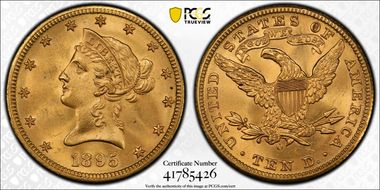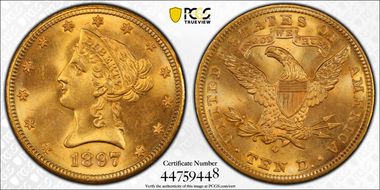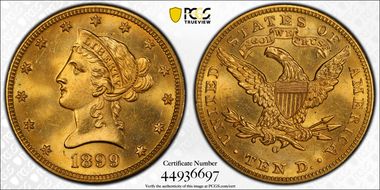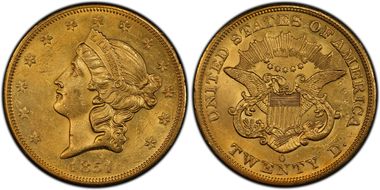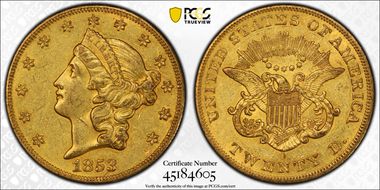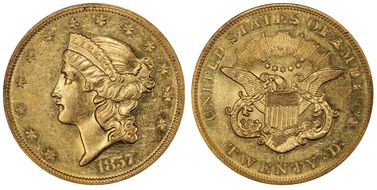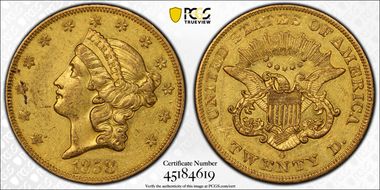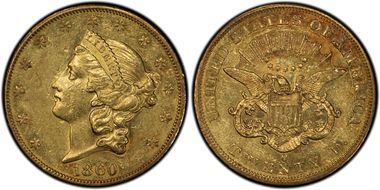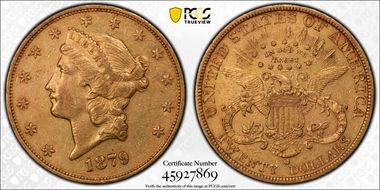400 Esplanade 的钱币相册
V-5. There are die cracks from the head to rim, through the 1st and 4th stars and rim to 8.
V-3. There are die cracks on the reverse thru A of STATES and both A's of AMERICA. CAC.
V-4. Medium O. Several reverse die cracks, including U, A & S of states, R & A of America. Even though 815,000 pieces were struck of the 1841-o, it is a rarely encountered issue, especially in high grades. Less than 75 submissions have occurred at the 2 major grading services. However, of those, 3 have achieved at least gem status.
V-1. Ex: Matthew Stickney, John H. Clapp (Henry Chapman 6/1907) to Louis E. Eliasberg, Sr. (1942); Eliasberg Collection (Bowers and Merena, 5/1996); Eugene Gardner via Joe O'Connor 2/2004, Tom Bender. CAC.
V-2. Medium O, the end of the shield points to the left of 1. Beautiful original toning covers this typically struck New Orleans mint coin. According to Al Blythe the Large O is R4 in mint state. This coin had been previously incorrectly attributed as Large O.
V-2. extensive peripheral die cracking, round fat O. Ex: O'Connor, Gardner, Bender. CAC.
V-1. 51 touches base, die crack thru last 5 stars. Ex: Simpson, Bender. CAC
V-1. The only known variety. Only 260,000 Seated half dimes were delivered by the New Orleans Mint in 1852, and the coins were melted almost as soon as they were produced. Al Blythe, in his book, The Complete Guide to Liberty Seated Half Dimes, rates this issue R.6 overall. Ex: Bender. CAC
V-1. The only known variety. Only 260,000 Seated half dimes were delivered by the New Orleans Mint in 1852, and the coins were melted almost as soon as they were produced. Al Blythe, in his book, The Complete Guide to Liberty Seated Half Dimes, rates this issue R.6 overall. Ex: Bender. CAC
V-3. The arrows are high and nearly touch the base. The date is also high and irregular with the 3 being lower. Die cracks are seen on the reverse above STATES. The mintmark is nearer the right bow. Ex: Gardner. CAC.
V-unmatched. This coin has a date that doesn't contact the base at all. Obverse die cracks are seen at the 6th star and the head. On the reverse, the o is low and a heavy crack is seen at the E of UNITED.
V-1. high date, die crack thru stars 1-5. low 7 in date. vertical line at rock base on left. With a mintage of 1.38 million, the 1857-o is a relatively common date. Apparently a number were set aside in mint condition as Al Blythe's 1992 reference on the series only rates the '57-O as R.3 in Unc. From the #1 ranked, retired Sounder Type Set at NGC. CAC
V-3. MM just right of wreath, Die crack through AMER(I)CA and at bottom of wreath
Fortin 104a. Ex: Simpson. Boldly repunched MM north and west, horizontal die crack across (U)NITED (DIME) AMERI(C)A
Fortin 109a. medium date, small o, Die crack at UN(I)TED and AME(R)ICA
Fortin 101, A-1. This issue is extremely difficult to locate in problem free VF or better. Only 19 submissions have achieved a higher numerical grade than this one as of June '11. From Rich Uhrich.
Fortin-104b. small o. Ex: Bender, Srotag, SBG Treasures of the SSNY sale '09. CAC.
Fortin 101, A-1: The date is punched very high with the 1 and 8 in the base of the rock. The mintmark is the large 'o' variety. There are 2 other mintmark sizes with the small o being rarest according to Gerry Fortin's reference.
Fortin 101. The date is high and slopes downward from left to right. This is the only known obverse. The mint mark is large, thin, and well centered. It is the more common of 2 known reverses.
Fortin 102. Even date, large thin MM. Ex: Kennywood, Branch Mint Collection. 1/0 at CAC.
Fortin 102. High date with slight slope downwards. The MM is the more common large variety. A diagnostic spur is seen at 8 o'clock on the 'O' of OF on the reverse. A real luster bomb that these crappy iPhone images fail to capture. Would easily + if resubmitted. Holdered >20 years ago. CAC.
Fortin 101: the only known die pair. This issue is actually rather elusive as evidenced by its mintage of 299,000. In Brian Greer's Complete Guide to Liberty Seated Dimes, the 58-o is known for soft strikes especially at the head, breast , and tail feathers. Luster is usually subdued on mint state pieces.
Fortin 103: medium level date, open 5, with die chips seen about star 5, medium o. A-2, G101. Ex. Superior Worrell Collection Lot 374 Sept 1993. CAC.
Fortin 106a. O/O. The 8 & 9 are repunched at the bottom. The attribution is clinched as the remnant of an o is visible within the medium o. Heavy die clashing is seen at the right of lady liberty. This is the late die state as cracks are beginning to form on either side of the mint mark. CAC.
This is the key date to the o-mint barber series. There are several mint mark and date position variations known, but none are considered varieties or errors.
The 1900-o is another issue that was sent to the Phillipines in large quantities. It rivals the 95-o in scarcity and commands a premium to most price guides according to the Stella Coin News reference on Barber Dimes.
Briggs 2C Die State. Extensive die cracking/shattering on the reverse. Small O MM. CAC
Briggs 3D. Extensive pedigree research by Gene Gardner led to the conclusion that this coin came out of the New Orleans Hoard of 1982. This treasure hoard was unearthed during the Hotel Meridien rennovation at the egde of the French Quarter. Several boxes of coins were broken open by an excavator digging beneath the sidewalk and locals began retrieving coins in the dirt, some in their business suits. Most were Spanish coins, but around a hundred seated quarters dated 1840, 41 were in the treasure. Before retrieval could be completed, the contractor filled the hole, covered it with cement, and continued rennovations. This event was one of several that sparked my interest in coin collecting at a young age. Ex: Gardner, Bender, Benedict. CAC.
Briggs 4F. Ex: Ronald W. Brown Acadiana Collection; Doug Winter. As of April 2008, none have been certified above MS63 at NGC and the PCGS population report of 30 for MS64 undoubtedly reflects resubmissions. This date is considered to be R7 in mint state and probably about 6 MS64s exist. Some believe the Pittman coin may be a gem, though the present coin certainly deserves that same consideration with no mentionable marks. The rest of the graded population amounts to a mere 40 coins with only a dozen in lower grades of mint state. In addition, the mintage of 769,000 includes coins actually minted in 1841. Ask yourself how often a mint state 42-o appears on the market...rarely.
Briggs 1B: It is likely a very early state of 1B because the die crack is just starting to form between the rim and D of UNITED. No other die cracks are seen on this coin.
Briggs 1a. The photos fail to fully capture lavender and citrus hues that bathe this nicely preserved beauty.
Briggs 1A: prominent die crack from rim to star 6/7 to R arm and L foot to rim. MM left of center with cobweb reverse
Briggs 1A. The mintage of 412,000 is healthy in terms of New Orleans coins. However, like many pre-1853 silver issues, a vast number were lost to melting when bullion prices exceeded the coin's face value. There is only one graded finer in MS64 at PCGS. Typical of this date, there is heavy die rust noted on the obverse with weak peripheral features probably from poor striking and excessive die polishing. Only 2 obverse and 3 reverse dies are thought to have been used.
Briggs 1B. Only 88,000 were coined and the average coin is poorly struck. Softness is usually seen as a flat, poorly defined head and weak star centrils. Only a few uncs are known including an NGC MS63 and a pair of 62s at PCGS.
Briggs 1B. Only 88,000 were coined and the average coin is poorly struck. Softness is usually seen as a flat, poorly defined head and weak star centrils. Only a few uncs are known including an NGC MS63 and a pair of 62s at PCGS.
Briggs 1B. The production of 96,000 is only one of several factors that ensure this issue's rarity. The California gold rush altered the gold-silver ratio allowing speculators to melt silver coins for a slim profit over face value. In addition to poor strikes, 52-o quarters were struck with a collar resulting in flatter rims and faster wear. The majority of survivors are impaired or heavily worn. Only a couple of uncs are known, an MS62 and an MS63. This coin is probably a bit net graded. I suspect it was stored for years in a cabinet face up as the reverse is a pristine, bright MS63-64 with full satiny luster and a nice strike. However, the obverse is dull and has some minor pitting. In addition the obverse strike is flat. I can find no wear on either side of this coin with a loope.
Briggs 2F. This coin is housed in the first generation of "old green holders" and is highly lustrous in hand. The photos just don't pick that up. Interestingly, this coin was likely slabbed around 1990-91 when the first green labels were used. The pigment used then was not stable and has now broken down into yellow.
Briggs 1A: Fortunately, none of the imaging of this coin revealed its true beauty. This coin is highly reflective and sharply struck. It is no surprise this coin is in a 64 holder-no one would question a + designation here.
Briggs 2B: Large O touching crotch, cracks thru uNITED STATES. Ex: Gardner.
Briggs 2B. The Briggs 1A is typically a fuller strike, with sharper star centrils and reverse legend. This coin however is only slightly mushy in the periphery. It has very attractive toning and lots of remaining luster. From an original mintage of 520,000, this issue is very difficult to acquire in mint state. Two are known finer, an MS64 and MS64+.
Briggs 2B: The numerals are thin at the base. No die lump is seen in the rock on the obverse.
Briggs 1B. In this year on the eve of the Civil War, the Seated quarter was produced at three mints, though not one of them had a mintage that exceeded 1 million pieces. The Philadelphia Mint produced only 804,400 coins, with New Orleans contributing 388,000, and San Francisco a meager 56,000. Today the average certified survivor is about EF, nice Aus are rare and unc’s are hard to locate. Six submissions have achieved gem status at the 2 major services, and it would be hard to imagine one more eye appealing than this near gem.
According to the references on Barber Quarters at Stella Coin News, this is a variety with die cracking through the top of Liberty's head and date. This is mint mark variety 3 of 4 described.
Ex: Gardner. NGC67 at the time of Heritage sale and crossed some time later.
Housed in a first generation holder, the scans further mute already subdued luster.
GR-1. RPM. This is the most common variety accounting for 90%+ of the 110k produced. Extensive die craking on both sides is also a diagnostic clue.
WB-5. Ex: Gene Gardner (Mike Printz and Larry Whitlow '09), Srotag. CAC.
WB-9R Remarriage. No foot support and die crack off the top off foot extending to star 13. Extensive reverse cracking. CAC
WB-37 (?) vs unmatched. possible LDS reverse with removed die lines from polishing but now with die cracks not mentioned in reference. Obverse may be unlisted with prominent die lines left of date diagonally near 1st star. Ex: Srotag. CAC.
WB-6. Issued from state of LA. Ex: Ronald W. Brown, Acadiana Collection, Stack's 9/84 Sale, lot 972;
WB-6. Issued from state of LA. Ex: Ronald W. Brown, Acadiana Collection, Stack's 9/84 Sale, lot 972;
Ex: J.M. Clapp, John H. Clapp, Louis Eliasberg, Sr., Larry Miller. Not long after publication of Augustus Heaton's Mint Marks in 1893, John M Clapp began a yearly purchase of mint state coins by writing to the various mints. This was one of the first he purchased directly from the New Orleans Mint though late in the year, November 1894. OGH. CAC
OC-1. The US Mint released its inventory of silver dollars in 1962-4 and it is accepted that between 1k-6k 60o's were let go. The majority are heavily abraded from rough handling during yearly mint accounting. The Bowers-Borckardt silver dollar Encyclopedia quotes Bruce Amspacher who wrote, "The average BU 1860-O dollar earned the nickname of 'Quaker Oats dollar,' because it looks like it was shot from guns."
The mint had been closed in 1861 after being claimed by Louisiana, then the Confederacy, and finally reclaimed by the U.S. In it's first year of operation since the Civil War, the mint managed to produced 2 quite famous coins numismatically, the Morgan Silver Dollar and the extraordinarily rare 1879-o $20 gold coin with a mintage of 2235. Over the next 30 years many political struggles ensued as operations of the New Orleans Mint were considered superfluous and its operation continued only for the political clout of LA politicans in that era. This first year New Olreans Morgan is all white with an above average strike and a very clean reverse.
Blazing luster and all white with a superbly struck and very clean reverse.
The 1882-o is relatively common in lower grades of mint state thanks to massive treasury releases of 1962 and 1963. However, true Gems are scarce and prior to 1996 there were few, if any MS 66 and MS 67 examples certified by the two major grading services. In 1990, a small hoard of exquisitely preserved 1882-o dollars surfaced at Heritage Rare Coin Galleries in Dallas. A family heirloom in the form of an old book had been prepared in 1882 for the 50th wedding anniversary of a New Orleans couple. Twenty new 1882-o Morgan dollars had been purchased from the New Orleans mint and were included with the book. The book and the coins remained together in the family until the day that Heritage purchased the coins. Most of the MS66 coins and one MS67 in the NGC and PCGS population reports originated from this source. There is one MS68 coin, ex. Jack Lee 1&2. This coin is all white and unusually clean in an older generation holder and perhaps an upgrade candidate.
The New Orleans Mint produced 8.7 million Silver Dollars in 1883, a significant total for any era. Since many of these coins were preserved in federal vaults, this issue is among the most common Morgan Dollars in Mint State. Nevertheless, the certified population of the 83-o drops off rapidly above the MS66 grade level, and both major grading services have seen slightly more than 50 coins in MS67 and none finer. This example is meticulously struck with fully deep mirrored fields. Trivial light marks over the cheek limit this conservatively graded beauty. Affixed with the CAC hologram.
The mintage of 9.7 million, the release of huge quantities from storage in the Washington, D.C. Treasury Building in the 1930 and 1950s, and from the Philadelphia Mint in the early 1960s, along with a hoard owned by the Continental-Illinois Bank, all combine to assure the ready availability of this issue in Mint State. Housed in an old green holder, this New Orleans gem is 100% white with an impeccable strike for similar coins of this year.
Older generation holder, possible upgrade candidate and one of the cleanest 66s I've seen. The 2 trivial grazes behind Liberty's head are only visible at certain angles, and of course the scan picks them both up. The rest of the coin is immaculate and nicely struck. This year is known for well-struck, well-preserved specimens as the population figures indicate. There are a surprising number of PL and DM coins also.
The 1886-o is one of the true condition rarities of the Morgan dollar series. The PCGS and NGC population for MS64 is a mere 300 and only 4 coins have achieved gem status. Most of the 10 million coins likely succumbed to melting as a result of the Pittman Act of 1918. In fact, it has been estimated that 6 to 8 million were lost in this manner. Additionally few were saved as evidenced by the ready availability of circulated coins and lack of uncirculated ones. This coin is certainly an exception with a nearly full strike and lovely white surfaces. From the Jack Lee Estate.
In his Silver Dollar Encyclopedia, Dave Bowers notes: "The typical Mint State coin is heavily bagmarked, has dull luster, and is poorly struck. As if that were not enough, it is apt to be in lower grade levels." Quantities of this issue were released from Treasury vaults over a period of years throughout the middle 20th century, with the latest coins being dispersed in 1964, among the last coins paid out. Nearly all of these coins from the Treasury were in the lowest Mint State grades. In fact, one silver dollar specialist stated that he actually found XF and AU grade coins in mint-sewn bags of these dollars. Aside from being all white, this has a very typical strike for New Orleans Morgans with a flat ear and poorly defined breast feathers.
This high mintage issue (11.8 million) was both widely distributed at the time of issue and also paid out in bag quantities beginning as early as 1938. The 1889-O is not known for its availability, but rather its poor striking quality. The result of this lack of details has the same effect as a lack of availability, i.e., very few pieces qualify at the Gem level. This piece is all white, but not quite fully struck.
The 1892-o Morgan is somewhat of an enigma to collectors. The mintage of more than 2 million suggests ready availability in all grades. However, because of the New Orleans Mint's failure to produce coins of high quality, finding well-preserved gem and near gem pieces can be difficult, costly, and time consuming. Strikes are usually poor and luster unimpressive. Expect to pay a premium when a well struck coin with vibrant luster surfaces. It is presumed by some including Wayne Miller that many of the better quality coins of this issue came from a mint bag that surfaced in 1977. This frosty, all-white near-gem has a much better than average strike including the central devices that are typically very flat.
The 1895-o is certainly the key to the New Orleans Morgan dollar series. In addition, 1895 continues to be the most notable year of the entire Morgan series. Much of this notariety is due to the mystery surrounding silver dollar production at the Philadelphia Mint in 1895. The New Orleans Mint production was limited to 450,000 pieces, a low mintage by the standards of any late 19th and 20th century silver series. The distribution of this issue is not unlike that of other O-mint issues from this era. A small number of coins, probably 100,000 pieces, were released into circulation in the South. The remainder of this mintage went into storage as did many other issues at the other branch mints. The Pittman Act of 1918 must have taken an unusual toll on the 1895-o, as few examples emerged from Treasury holdings in the early 60s. Due to the limited original mintage, it is likely that most of the 1895-O dollars went to the melting pot under the terms of this act. Circulated examples are scarce on today's market, and Mint State representatives are deservedly rare. For the BU purist a circulated example would never do. However, this coin is more than a hole filler. The soft gray patina over the vast surfaces of this silver beauty are as eye-appealing as the frosty surfaces of a mint gem. The few Mint State survivors of this issue include a large percentage of poorly struck, lackluster, and/or heavily abraded coins.
With a mintage of 4 million coins, the 1897-o dollar at first glance might be considered a common date. However, it is believed that more than 1 million were melted under the 1918 Pittman Act, with the vast majority entering into circulation. A small number of bags were released by the Treasury in the mid-1900s and those coins were said to be of poor quality. The usual 1897-o dollar typically displays poor luster and an incomplete strike. As a result, near-gem or better examples are scarce or, more accurately stated, rare. Only a dozen are known in Gem or better through MS67 at PCGS. This example is well struck especially centrally, and is actually far brighter than my scans show. Hard to believe it's only a 61.
This is one of three Morgan Silver Dollar issues, along with 03-o and 04-o, that had been considered rare prior to release of the Treasury Hoard of the 1960s. Of the 4.44 million 98-o dollars, a substantial percentage was set aside and eventually distributed through the Federal Reserve System in late 1962. Few, however, show the well preserved surfaces seen on this piece. This coin is all white and only has light grazes that show up amazing well on these high resolution scans.
VAM 11A: doubled 1, high o tilted right, reverse die breaks. Beautifully struck and 100% white. There is die cracking on the reverse extending almost circumferentially through the lettering.
VAM 40: Doubled ear, near date, high o, with die lines around eagle. All white with amazing mint frost and not a bad strike for this date.
All white and nicely struck with loads of frost. There is some interesting die cracking noted on the reverse extending through the F and Eagle's wing as well as throught the MER of AMERICA.
This coin has mirrored fields and curiously did not achieve at least a PL designation. The strike is full and minimal marks are noted accounting for the high grade.
Winter V-1: weak stars at the top, bolder at the bottom. GOLD CAC. Ex: Duckor, Simpson.
Winter V-1. The date punch entered the date slightly higher than the other variety. Among all gold dollars struck in New Orleans, the 1853-O is the easiest to locate in all grades. With a mintage of 290,000 coins, it is tied with the 1851-O for the highest mintage gold dollar of this Mint.
Winter V-2. Ex: Harry Bass, Jr via John Rowe and Mike Brownlee privately 2/24/1967 and impounded in the ANA Money Museum in Colorado Springs until its current release. CAC
Winter V-2: Low date, close fraction. This is the finest known of the close fraction group. The 64, 4+, and 5 are all wide fraction. This is a late die state with shattering.
Winter V-1. The mint mark is large and high compared to the other 2 varieties and diagonal lines are seen above ST in STATES. The strike is notably weak at the center, also a characteristic of this variety. From a mintage of 33,580, about 100-125 remain. This coin is probably a 62-63 technically with no visible wear, but the strike is very soft. CAC
Winter V-1. The fields are remarkably prooflike and this is a fully struck example-a rarity for this already rare issue.
Winter V-3. The mint mark extends rightward past the fraction bar, and the feather enters the center of the 'O'. This is an issue that is notable for weak strikes.
Winter V-1. Ex: Bass. The one is buried in the dentils and is doubled at its base (Obv1). The Mint Mark is penetrated by arrow feathers and is centered over the fraction bar (RevA). The provenance is not on the holder but matches the Bass II 407 coin, formerly PCGS MS63 at the time of sale in October 1999. There is a copper spot on the reverse at the 2. Thank you Stephen Davidson for locating this coin.
Winter V-4. Low date with recut 5. MM left touching claw. There are a number of underrated issues among New Orleans gold coins. The current issue would certainly be one of them. Long considered to be virtually unknown in Mint State grades, recently a few pieces have been certified in grades as high as MS64, yet coins as fine as the present example remain few and far between. This piece, unusual for the date, has a nearly full strike. Ex. Grand Lake Collection (HA 2/09).
Winter V-2. No evidence of repunching or doubling of date. This is the rarer variety.
Winter V-1. Ex: Harry Bass. This is the rarer of the two varieties according to Doug Winter and is notable for the tail feathers penetrating the mint mark.
Winter variety unmatched. The 1 is in the neck (Obv5) and the MM is left enough that no feathers puncture it (RevA)
Winter V-2. The more common variety struck from lapped dies. The 1854-o is the first year of issue and the only $3 coin produced at the New Orleans branch mint. With a total mintage of 24,000, most of the coins were presumed to be released into circulation or melted. Only 2 mint state examples are currently slabbed by PCGS (an MS61 and an MS62). Though around 1000 are preserved in PCGS and NGC slabs, the popularity among us collectors make this a difficult date to locate in any grade.
Winter V-3. Narrow Mill. Unique 'railroad rim' error. Ex: Eliasberg, Bass.
Winter V-2, This is die state II according to Doug Winter's new book. There is a light die crack from star 12 to rim and light peripheral cracking on the reverse. From the New England collection.
Winter V-3. MM is lower and tilted left, right shield line curves inward. Despite a mintage of 58,000, the 46-o is rarer than the 45-o (41,000). According to Doug Winter's book on New Orleans gold, only 4 or 5 uncs are known and the population figures at PCGS and NGC likely represent resubmission of the same few uncs. This coin has a lovely cameo effect with prooflike fields. Marks through the eagle's head and neck are on the holder. CAC.
Winter V-1. The only known variety. The 47-o is the rarest of the o-mint half eagles. According to Winter's reference, there may be only 40-50 known in all grades and in properly graded AU55 there are no more than a few pieces known. There is one MS61 at NGC and likely only one other coin that would grade AU58.
Winter V-2. Ex: Reportedly resided in a Wayte Raymond coin board prior to auction via The Old Colony Collection (ANR, 12/2005), Allan H. Goldman Collection.
Winter V-1. MM is lower and more left compared with v2. Doubled 'R' in AMERICA.
Winter V-1: The only known variety. The reverse is the same as on 55-o. This is the least produced half eagle along with the 92-o at 10,000 minted.
Winter V-1. Ex: Fairmont. Reportedly, this is the best of the last of a group of hand selected coins from a European hoard of 400k+ US gold coins kept in vaults for 100+ years. CAC.
Winter V-1. The mintmark is positioned left of the crotch near the fletchling and claw.
Winter V-1. The mintmark is positioned left of the crotch near the fletchling and claw.
Winter V-2. The o is lower than V-1. V-1 uses the 41-o reverse. Only 27,400 eagles were produced in 1842.
Winter V-2. No die cracks on reverse, stronger date. Submitted raw from a long held collection in CO. Graded by several trusted numismatists higher than the current label. Absolutely fresh and probably warrants a '+' at the very least. Likely also the finest known to date (2021).
Winter V-1. This date is notable for one of the most important coins produced by the New Orleans Mint...a remarkable NGC PR66 that traded for 1.5 mil in 07!!! It is not known why this single proof was produced. OGH.
Winter V-1A. Repunched date with MM centered over the N of TEN. In hand, this coin is very flashy and this is not captured by the images provided. CAC
Winter V-1. Ex: Warren Miller. The rarity of MS64 'no motto' Eagles from the New Orleans mint cannot be overstated. Fewer than 10 are likely to exist at MS64 and above. OBH. CAC.
Winter V-1. Ex: SSCA. Cracked out of special large holder to upgrade, but not by me. CAC
Winter V-1. The only small date variety. It is unknown how many of the 52,500 delivered were of the small logotype. Doug Winter estimates that the small date is more common overall, but more difficult in higher grade. Only 1 low grade unc is known at PCGS and 2 at NGC.
Winter V-1: normal date. The average 1855-o is heavily abraded and has lack luster eye appeal. There are only 2 known uncirculated coins, both MS61s in PCGS holders. Less than 100 of the original 18,000 are thought to have survived.
Winter V-1. Ex: Clapp, Eliasberg, Harvey Jacobson (per DW, but not on holder). CAC
Winter V-1. This coin has no known provenance, but on close inspection a lot of dirt is seen in the protected areas ie.- around the stars, within the numerals. I suspect this coin might be from the Tennessee Hoard of 1985...but no proof exists. This coin is so super-original with a beautiful matte finish. It is very minimally abraded just as the pictures show and in my opinion is quite conservatively graded. OGH. CAC.
Winter V-1. Ex. SS Republic. In October 1865 after the Civil war ended, the ill-fated sidewheel steamship left New York en route to New Orleans with gold, silver, and commercial cargo to resupply the depleted Southern economy. The ship sank one week later 100 miles SE of Savannah, GA on October 25 in a hurricane. Passengers and crew escaped, but the ship and her booty were lost. In 2003, Odyssey Marine Exploration located the wreck and began the process of recovery. Some amazing rarities came out of the treasure, including the 2 finest known 59-o $10s. Sea salvaged silver coins from the wreck were etched by decades of exposure to salt water. However, the gold coins were largely unaffected. This coin is amazingly well preserved though abraded. I cannot find rub on this coin, but perhaps muted luster on the obverse prevents a higher designation. The protected areas are bright and prooflike, and the reverse is easily MS62. The 1859-o is the rarest "No motto" eagle with a total mintage of 2300 and survival is estimated at 45-55 coins.
Winter V-1. Ex: Admiral Collection. Definitely not a 55, and most likely a 60-61 by today's standards. There is no visible difference in this coin and the professionally photographed 80-o MS61, the next entry in this collection. OGH. CAC.
Ex: Clapp/Eliasberg. J.M. Clapp purchased this eagle directly from the mint at 400 Esplanade Avenue in New Orleans in 1903 and it was passed on to his son after his death in 1906. It was then sold to Louis Eliasberg after J.H. Clapp died in 1942. The coin was sold at auction in the Eliasberg sale of 1982. It had reportedly not changed hands since the Eliasberg sale...until now. OGH. CAC
Winter V-1. Hundreds have been located overseas in the last decade according to Doug Winter. There is one interesting coin for this issue, possibly a specimen or proof strike. A note accompanies that coin, "First Gold Coined 1904, W.J.Bromphy, Coiner US Mint, $10.00 and $5.00" Interestingly, no gold half eagles are currently known for this date?!?!
Winter V-1. The 1852-o is the most available New Orleans double eagle in higher grades with 12-18 Unc's available.
Winter V-1: the only known variety. From a mintage of 8,000, probably 70-80 remain. None of these are full unc's despite a few in NGC60 holders according to Winter. Overall, this issue is considered the 3rd rarest among New Orleans double eagles. CAC.
Winter V-1: Per Doug Winter, "I doubt if more than three or four have what could be termed as “positive” eye appeal. The typical 1859-O has been stripped and shows excessive abrasions. Pieces with original color and skin are rare, rare, rare!! It has been years since I’ve seen an 1859-O which I’ve liked. This coin? I LOVE it…Housed in an old green label holder and clearly undergraded by today’s standards; I think virtually anyone viewing this coin will call it a solid AU55." Hmm, 'nuff said! OGH. CAC.
Winter V-1. Tied for finest known (2015). Repatriated from France-very PL. CAC.
Winter V-1. Tied for finest known (2015). Repatriated from France-very PL. CAC.





















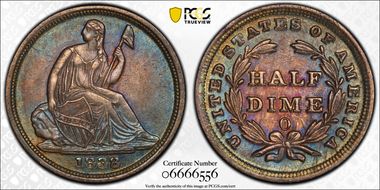








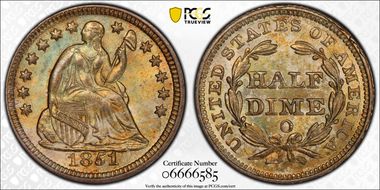
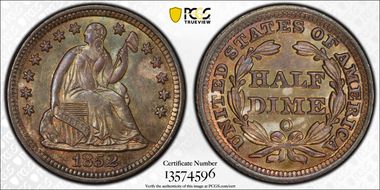






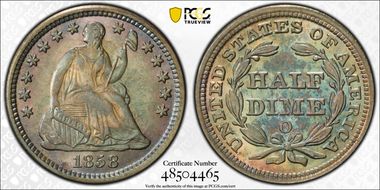
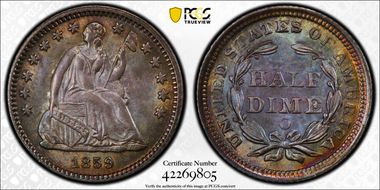
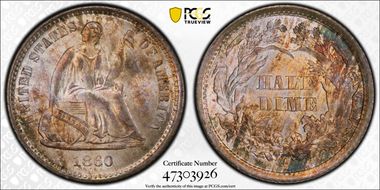

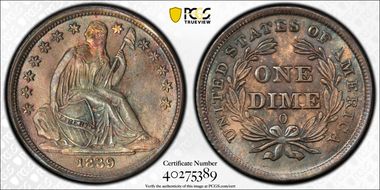





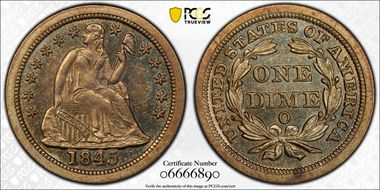

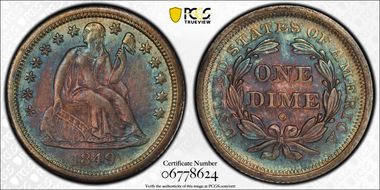




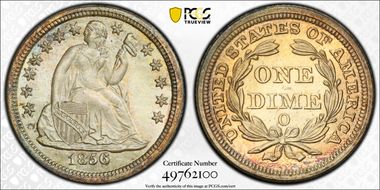





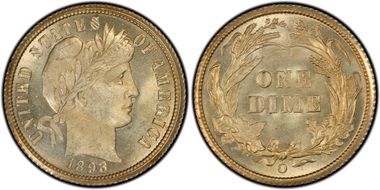
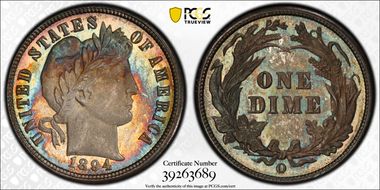






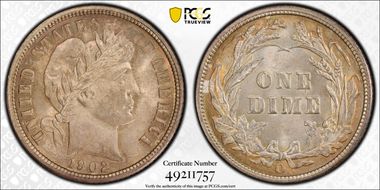
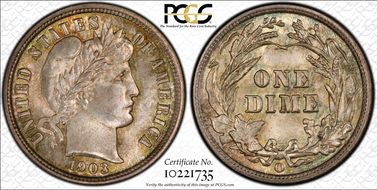


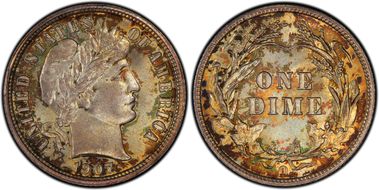
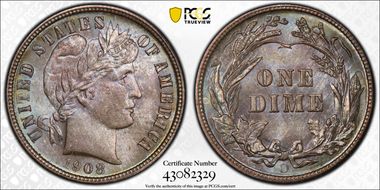






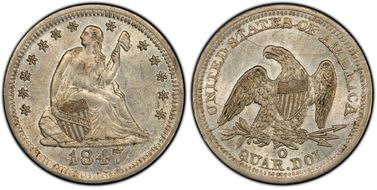

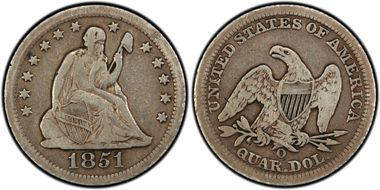


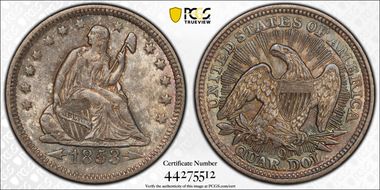




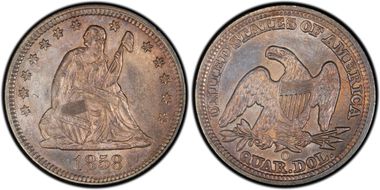




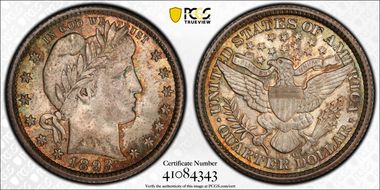



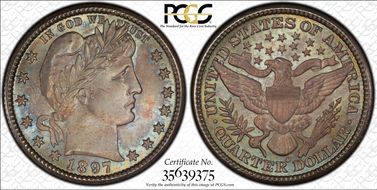


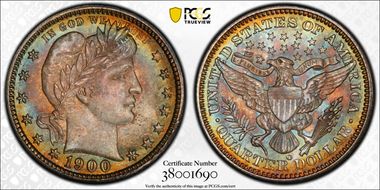

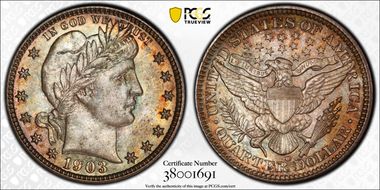
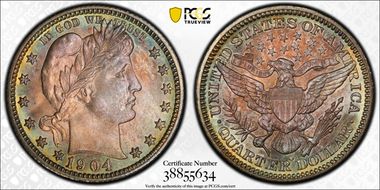

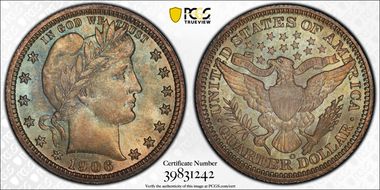
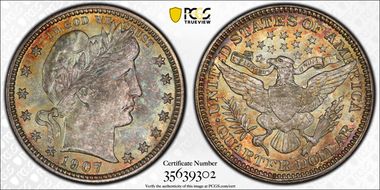


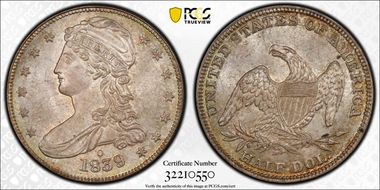
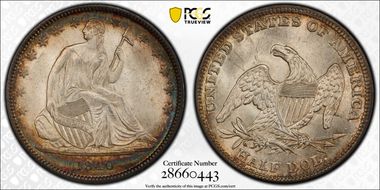





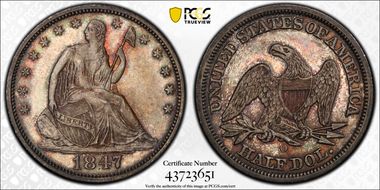

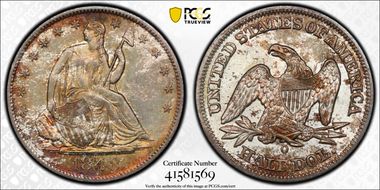








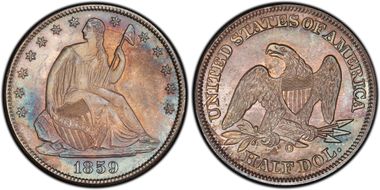



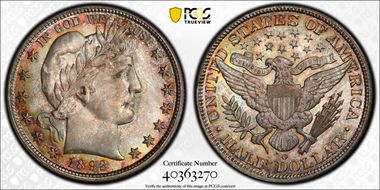
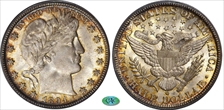
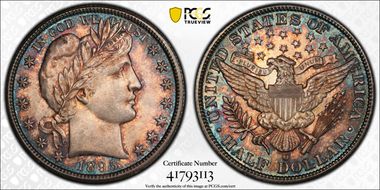
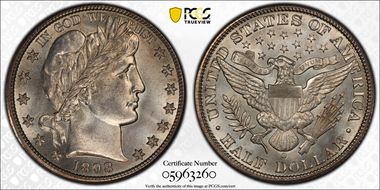



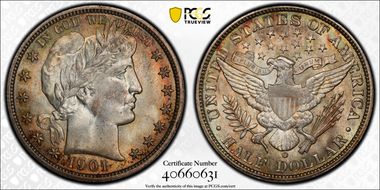
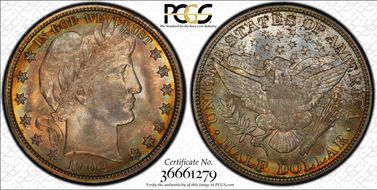
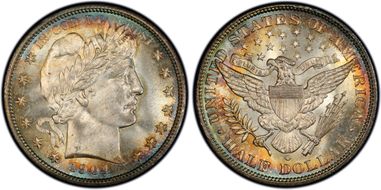


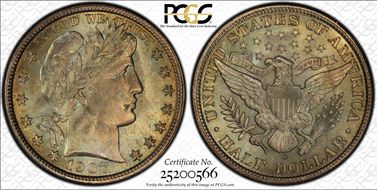



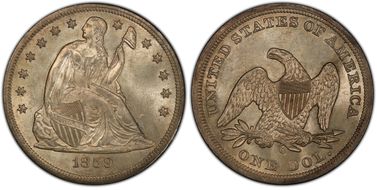


























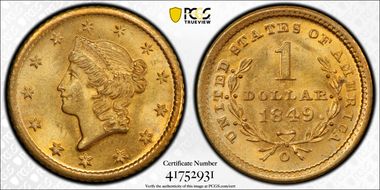

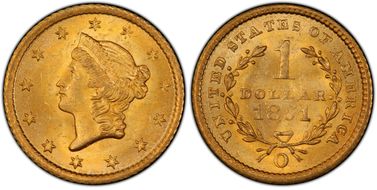
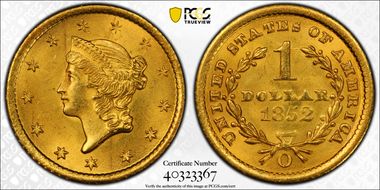
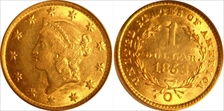
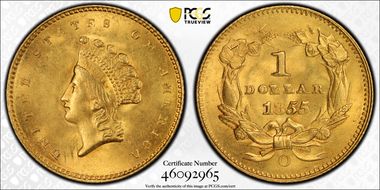
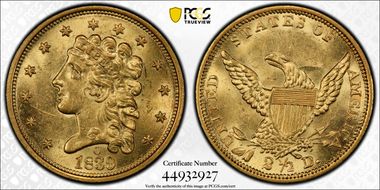







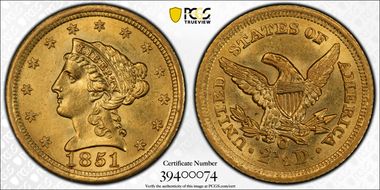







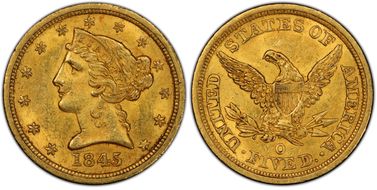






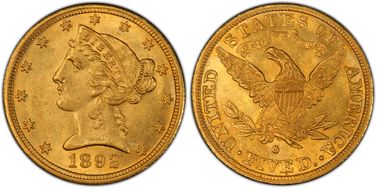
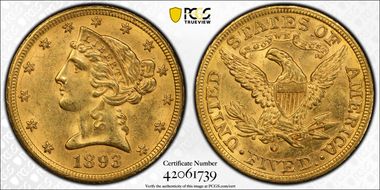









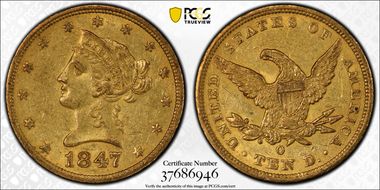




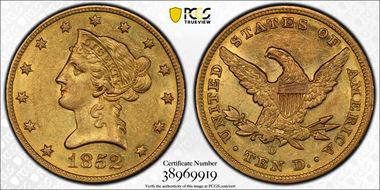



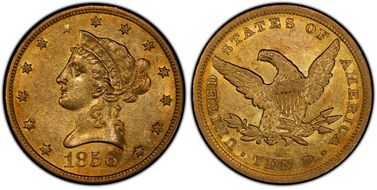






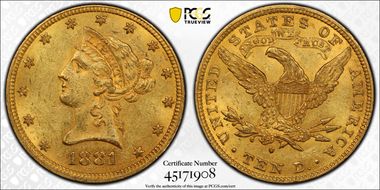
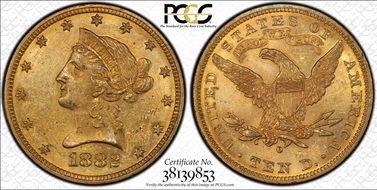
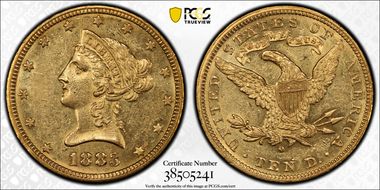


_album.jpg)

